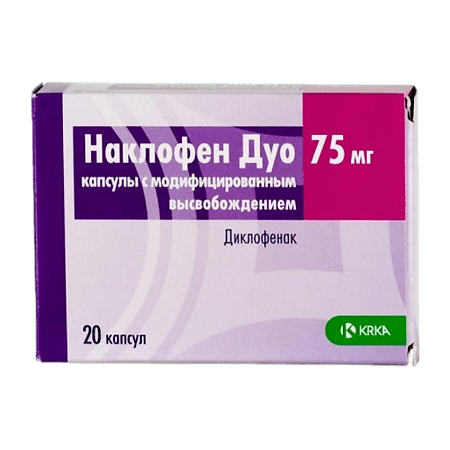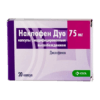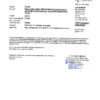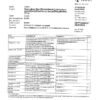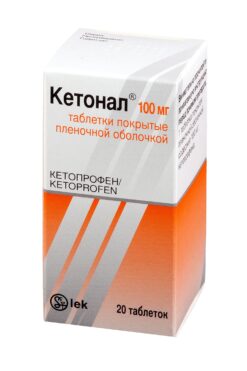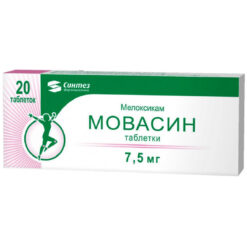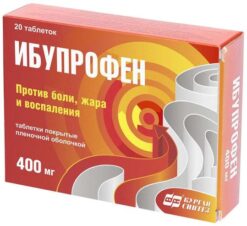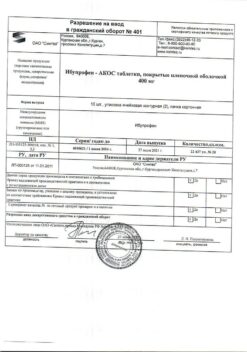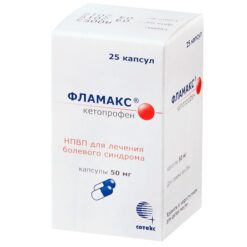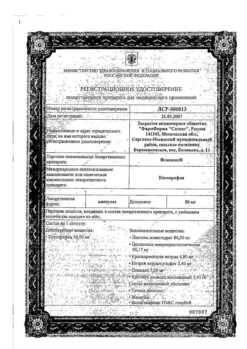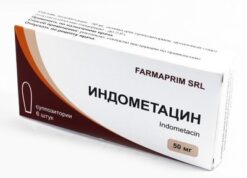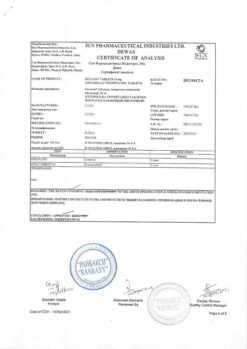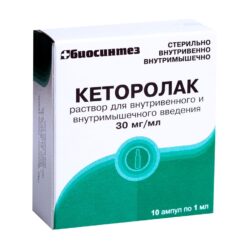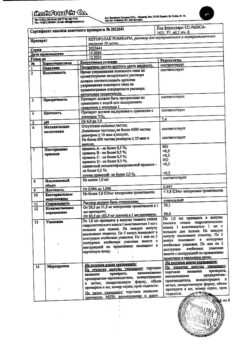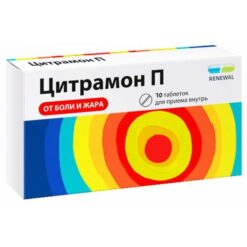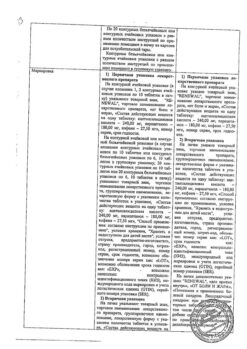No products in the cart.
Naclofen Duo, 75 mg 20 pcs
€1.00
Out of stock
(E-mail when Stock is available)
Description
Pharmgroup:
NSAIDs.
Pharm Action:
Naclofen Duo is an NSAID with analgesic, anti-inflammatory and antipyretic effects. Its main mechanism of action and related side effects are non-selective inhibition of COX-1 and COX-2 activity, which leads to disruption of arachidonic acid metabolism, reduced synthesis of prostaglandins, prostacyclin and thromboxane. The level of various prostaglandins in the urine, gastric mucosa and synovial fluid decreases.
It is most effective for pain of inflammatory nature. In rheumatic diseases the anti-inflammatory and analgesic effect of diclofenac contributes to a significant reduction in the severity of pain, morning stiffness, joint swelling which improves the functional state of the joint. In injuries, in the postoperative period diclofenac reduces pain and inflammatory swelling.
Like all NSAIDs, diclofenac has antiaggregant activity. In therapeutic doses, diclofenac sodium has almost no effect on bleeding time. With long-term treatment the analgesic effect of diclofenac sodium is not reduced.
Pharmacokinetics:
Absorption
Absorption is fast and complete. Diclofenac is contained in Naclofen Duo capsules in the form of enteric and prolonged-release pellets, so Naclofen Duo capsules have immediate and prolonged effects. Cmax in plasma is noted 30-60 min after administration. The therapeutic concentration is maintained twice as long as with enteric film-coated tablets. Plasma concentrations are linearly related to the dose taken. No changes in pharmacokinetics of diclofenac against repeated administration are noted. It does not cumulate if the recommended interval between meals is observed.
Distribution
Bioavailability – 50%. Binding with plasma proteins – more than 99% (most of it binds with albumin). It penetrates into the synovial fluid. Cmax in synovial fluid is observed 2-4 hours later than in plasma. Diclofenac is more slowly excreted from synovial fluid than from plasma.
Vd – 550 ml/kg. Diclofenac penetrates into breast milk.
Metabolism and excretion
50% of the active substance is metabolized during the “first passage” through the liver. Metabolism occurs as a result of multiple or single hydroxylation and conjugation with glucuronic acid. Cytochrome P450 enzymes are involved in metabolism of the drug. Pharmacological activity of metabolites is lower than activity of diclofenac.
Systemic clearance is 260 ml/min, T1/2 – 2 hours. About 70% of the administered dose is excreted as pharmacologically inactive metabolites by the kidneys; less than 1% is excreted unchanged, the rest of the dose is excreted as metabolites in the bile.
Pharmacokinetics in special clinical cases
In patients with significant renal insufficiency (CKR less than 10 ml/min) excretion of metabolites in bile is increased, while there is no increase of their concentration in blood.
In patients with chronic hepatitis or compensated liver cirrhosis as well as in elderly patients pharmacokinetic parameters of diclofenac are not changed.
Indications
Indications
Active ingredient
Active ingredient
Composition
Composition
1 capsule:
diclofenac sodium 75 mg, incl:
– diclofenac sodium (in enteric soluble pellets) 25 mg
– diclofenac sodium (in prolonged release pellets) 50 mg
Excipients:
The enteric pellets are sugar spheres (sucrose content not more than 92%),
hyprolose (hydroxypropylcellulose),
hypromellose,
magnesium carbonate heavy,
methacrylic acid and ethyl acrylate copolymer (1:1) 30% dispersion,
triethylcitrate,
talc,
titanium dioxide,
sodium carboxymethylcellulose,
macrogol,
sodium hydroxide;
pellets with prolonged release – sugar spheres (sucrose content not more than 92%),
ammonium methacrylate copolymer (type A),
ammonium methacrylate copolymer (type B),
How to take, the dosage
How to take, the dosage
The drug Naclofen Duo is taken orally. The capsule should be swallowed whole with water at the end or after a meal, usually in the morning.
Prescribed individually, taking into account the severity of the disease. Adults are usually prescribed 75 mg (1 capsule) 1-2 times a day. The maximum daily dose is 150 mg.
Interaction
Interaction
Concomitant use of diclofenac increases plasma concentrations of digoxin, methotrexate, lithium drugs and cyclosporine.
Diclofenac reduces the effect of diuretics; against potassium-saving diuretics the risk of hyperkalemia increases.
When diclofenac is used against anticoagulants, antiplatelet and thrombolytic drugs (alteplase, streptokinase, urokinase) the risk of bleeding increases (often from GI tract).
When used concomitantly diclofenac reduces the effect of hypotensive and hypnotic drugs.
Diclofenac increases the risk of side effects of other NSAIDs and GCS (GI bleeding), methotrexate toxicity and cyclosporine nephrotoxicity.
Acetylsalicylic acid reduces the blood concentration of diclofenac. Concomitant use with paracetamol increases the risk of nephrotoxic effects of diclofenac.
Hypo- or hyperglycemia may be observed when taking hypoglycemic agents against the background of diclofenac use. Blood sugar levels should be controlled with this combination of agents;
Cefamandole, cefoperazone, cefotetan, valproic acid and plikamycin increase the incidence of hypoprothrombinemia when used concomitantly with diclofenac.
Cyclosporine and gold drugs increase the effect of diclofenac on the synthesis of prostaglandins in the kidneys, which is manifested by increased nephrotoxicity.
Selective serotonin reuptake inhibitors increase the risk of GI bleeding during concomitant use of diclofenac.
The concomitant use of diclofenac with ethanol, colchicine, corticotropin and St John’s wort preparations increases the risk of GI bleeding.
Drugs that cause photosensitization increase the sensitizing effect of diclofenac to ultraviolet radiation.
Drugs that block tubular secretion increase the plasma concentration of diclofenac, thereby increasing its toxicity.
The simultaneous use of antibacterial drugs from quinolone group with diclofenac causes the risk of seizures.
Special Instructions
Special Instructions
In order to quickly achieve the desired therapeutic effect the drug Naclofen Duo is taken 30 min before a meal. In other cases it is taken before, during or after a meal in whole, with plenty of water.
To reduce the risk of gastrointestinal adverse events, the lowest effective dose should be used in the shortest possible course.
Naclofen Duo should be used with caution in ulcerative colitis and Crohn’s disease because of the possible exacerbation of the disease.
In prolonged use of diclofenac it is possible, although in rare cases, the development of serious hepatotoxic reactions, in this regard it is recommended to monitor the liver function regularly.
Because of the important role of prostaglandins in maintenance of renal blood flow special caution should be exercised when prescribing the drug in patients with cardiac or renal insufficiency, as well as during therapy in elderly patients who take diuretics and patients who for any reason have decreased BOD (for example, after major surgical intervention). If diclofenac is prescribed in these cases, it is recommended to monitor renal function as a precautionary measure.
With caution, diclofenac should be prescribed for patients with blood clotting disorders, in porphyria, epilepsy, and patients receiving anticoagulants or fibrinolytics.
In long-term therapy it is necessary to monitor the picture of peripheral blood, to conduct fecal occult blood test.
Due to the negative effect on fertility, the drug is not recommended for women who want to become pregnant. In patients with infertility (including those undergoing examination) it is recommended to cancel the drug.
Patients taking the drug should refrain from drinking alcohol.
In infectious diseases, the anti-inflammatory and antipyretic effects of diclofenac sodium may mask the symptoms of these diseases.
The amount of sucrose contained in the drug does not affect patients with the following conditions: lactase enzyme deficiency, galactosemia and impaired glucose/galactose absorption syndrome.
Impact on driving and operating machinery
Mental and motor reaction times may decrease during treatment; therefore, it is necessary to refrain from engaging in potentially dangerous activities requiring increased concentration and quick psychomotor reactions.
Contraindications
Contraindications
– complete or incomplete combination of bronchial asthma, recurrent nasal and paranasal sinus polyposis and intolerance to acetylsalicylic acid and other NSAIDs (including In anamnesis);
– period after coronary artery bypass grafting;
– erosive-ulcerative changes of gastric or duodenal mucosa, active gastrointestinal bleeding;
– inflammatory bowel diseases in the acute phase (UC, Crohn’s disease);
– cerebrovascular bleeding or other bleeding and hemostasis disorders;
– expressed hepatic insufficiency or active liver disease;
– expressed renal insufficiency (CK less than 30 ml/min), including Ñ. Certain hyperkalemia, advanced renal disease;
– Decompensated heart failure;
– Inhibition of medullary hematopoiesis;
– III trimester of pregnancy;
– lactation period (breastfeeding);
– childhood (under 18 years);
– hypersensitivity to diclofenac.
. Naclofen Duo should be used with caution in case of CHD, cerebrovascular diseases, dyslipidemia/hyperlipidemia, diabetes mellitus, peripheral arterial disease, smoking, IQ less than 60 ml/min, anamnestic data on the development of gastrointestinal ulcers, presence of Helicobacter pylori infection, long-term use of NSAIDs, frequent alcohol consumption, severe somatic diseases, inducible porphyria, epilepsy, diverticulitis, systemic connective tissue diseases, significant decrease of the BOD (incl.Ñ. After massive surgery), elderly patients (administered in lower doses), including those receiving diuretics. patients receiving diuretics, frail patients and patients with low body weight, in I and II trimesters of pregnancy, with concomitant therapy with the following drugs: anticoagulants (e.g., warfarin), antiaggregants (e.g., acetylsalicylic acid, clopidogrel), oral glucocorticoids (e.g., prednisolone), selective serotonin reuptake inhibitors (e.g., citalopram, fluoxetine, paroxetine, sertraline).
Side effects
Side effects
Frequently, 1-10%; sometimes, 0.1-1%; rarely, 0.01-0.1%; very rarely, less than 0.01%, including isolated cases.
Digestive system disorders: frequent – epigastric pain, abdominal cramps, nausea, vomiting, diarrhea, dyspepsia, flatulence, anorexia, increased aminotransferase activity; Rarely – gastritis, gastrointestinal bleeding (vomiting blood, melena, diarrhea with blood admixture), gastrointestinal ulcers (with or without bleeding or perforation), hepatitis, jaundice, liver function abnormality; very rare – stomatitis, glossitis, dry mucous membranes (including mouth).including mouth), esophageal damage, diaphragm-like intestinal strictures (nonspecific hemorrhagic colitis, exacerbation of ulcerative colitis or Crohn’s disease), constipation, pancreatitis, lightning-fast hepatitis.
Nervous system disorders: frequently – headache, dizziness; rarely – somnolence; very rarely – sensory disorders, including paraesthesia, memory disorders, tremor, seizures, anxiety, cerebrovascular disorders, aseptic meningitis, disorientation, depression, insomnia, “nightmares” dreams, irritability, agitation, mental disorders.
Sensory organs: often – vertigo; very rare – visual impairment (blurred vision, diplopia), hearing impairment, tinnitus, impaired sense of taste.
Urinary system disorders: very rarely – acute renal failure, hematuria, proteinuria, interstitial nephritis, nephrotic syndrome, papillary necrosis, edema.
Hematopoietic organs: very rarely – thrombocytopenia, leukopenia, eosinophilia, hemolytic and aplastic anemia, agranulocytosis.
Allergic reactions: anaphylactic/anaphylactoid reactions, including marked BP decrease and shock; very rare – angioedema (including face). The drug contains methyl parahydroxybenzoate and propyl parahydroxybenzoate, which may cause allergic reactions.
Cardiovascular system disorders: very rare – palpitation, tachycardia, extrasystole, chest pain, increased BP, vasculitis, heart failure, myocardial infarction.
Respiratory system disorders: rarely – cough, bronchial asthma (including dyspnea); very rarely – pneumonitis, laryngeal edema.
Dermatological reactions: frequent – skin rash; rare – urticaria; very rare – bullous rash, eczema, erythema multiforme, Stevens-Johnson syndrome, Lyell syndrome, exfoliative dermatitis, skin itching, hair loss, photosensitization, purpura, including allergic.
Overdose
Overdose
Symptoms: vomiting, nausea, abdominal pain, GI bleeding, diarrhea, headache, dizziness, tinnitus, hyperexcitability, hyperventilation phenomena with increased seizure readiness, seizures, with significant overdose – acute renal failure, hepatotoxic effect.
Treatment: gastric lavage, activated charcoal, symptomatic therapy aimed at elimination of increased BP, impaired renal function, convulsions, gastrointestinal irritation, respiratory depression. Forced diuresis, hemodialysis are ineffective (significant protein binding and intense metabolism).
Similarities
Similarities
Additional information
| Shelf life | 3 years |
|---|---|
| Conditions of storage | At a temperature not exceeding 30 °C |
| Manufacturer | KRKA dd Novo mesto, Slovenia |
| Medication form | modified-release capsules |
| Brand | KRKA dd Novo mesto |
Related products
Buy Naclofen Duo, 75 mg 20 pcs with delivery to USA, UK, Europe and over 120 other countries.

